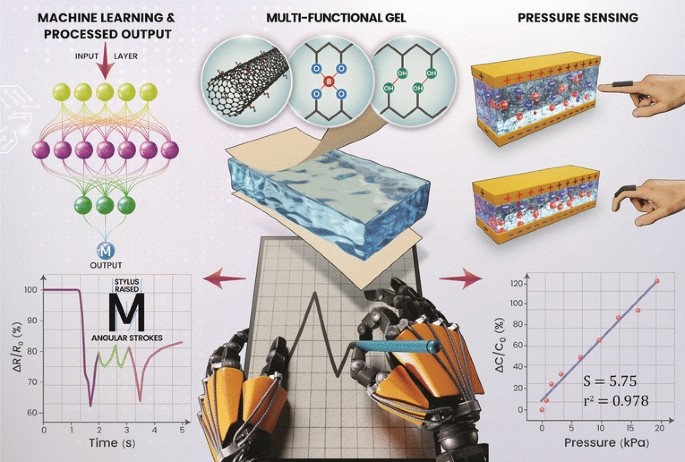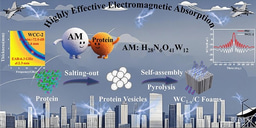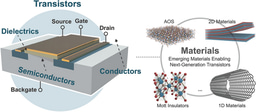Deep Learning-Assisted Organogel Pressure Sensor for Alphabet Recognition and Bio-Mechanical Motion Monitoring
Published in Bioengineering & Biotechnology, Materials, and Computational Sciences

As wearable electronics migrate toward real-time health monitoring and seamless human–machine interfaces, conventional hydrogels freeze, dry out and fracture under daily conditions. Now, a multidisciplinary team led by Prof. Sang-Jae Kim (Jeju National University) has unveiled a CoN-CNT/PVA/GLE organogel sensor that marries sub-zero toughness with AI-grade pattern recognition. The device delivers 5.75 kPa-1 sensitivity across 0–20 kPa, heals in 0.24 s, and classifies handwritten English letters at 98 % accuracy—offering a robust, bio-compatible platform for next-generation soft robotics and personalized healthcare.
Why the CoN-CNT Organogel Matters
• Freeze-Tolerant & Anti-Dehydration: Binary ethylene-glycol/water solvent and Co–Nx coordination keep conductivity at 1.10 mS cm-1 down to −20 °C and 95 % RH for >75 days.
• Self-Healing & Adhesive: Dynamic borate-ester bridges and hydrogen bonding restore 88 % mechanical strength in 60 min and stick stably to skin, wood, glass and curved plastics.
• AI-Ready Sensing: Piezo-capacitive response captures stroke pressure, lift-off and curvature, enabling 1D-CNN + XGBoost models to discriminate all 26 letters and digits with <2 % error.
Innovative Design and Features
• Hybrid Conductive Network: Cobalt-nanoparticle@nitrogen-doped CNTs provide metallic pathways, interfacial polarization and antioxidant shells, outperforming pristine CNT or ionic fillers.
• Dual-Crosslink Matrix: FDA-recognized PVA and biodegradable gelatin form reversible boronate esters; EG plasticizer suppresses ice crystallization and maintains chain mobility.
• Deep-Learning Pipeline: Sliding-window feature extraction → CNN-LSTM temporal encoder → XGBoost meta-classifier; robust to variable writing speed and pressure (95 % accuracy under perturbation).
Applications and Future Outlook
• Multimodal Health Patches: Real-time tracking of finger/wrist bending, throat vibrations during speech and gait asymmetry for rehabilitation and tele-medicine.
• Soft Robotics Interface: Ultra-low detection limit (≈20 Pa) enables tactile feedback for prosthetic grasping and collaborative robot arms.
• Challenges & Opportunities: Scaling roll-to-roll slot-die coating, integrating wireless BLE SoCs and extending vocabulary to Chinese characters and sign-language gestures are next milestones.
This work provides a comprehensive material-plus-AI blueprint for durable, intelligent wearable sensors that operate reliably from Arctic drones to tropical wearables. Stay tuned for further breakthroughs from Prof. Kim’s team!
Follow the Topic
-
Nano-Micro Letters

Nano-Micro Letters is a peer-reviewed, international, interdisciplinary and open-access journal that focus on science, experiments, engineering, technologies and applications of nano- or microscale structure and system in physics, chemistry, biology, material science, and pharmacy.






Please sign in or register for FREE
If you are a registered user on Research Communities by Springer Nature, please sign in